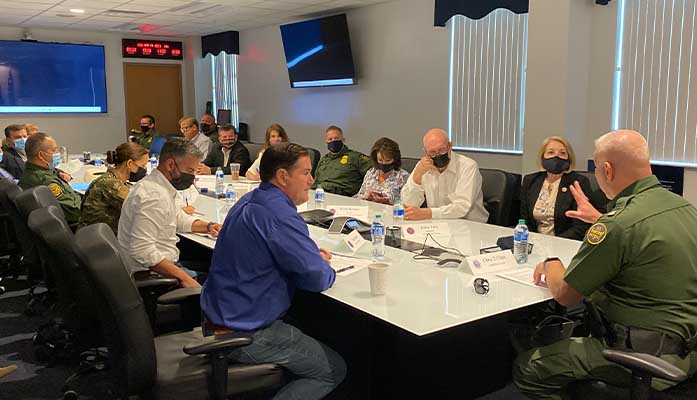On Wednesday, Governor Doug Ducey and a delegation of state lawmakers travelled to Yuma to call on the Biden administration to address the escalating humanitarian and security crisis on the U.S. / Mexico border. The officials received a briefing from U.S. Border Patrol, local law enforcement and community leaders.
The Governor was joined by Senate President Karen Fann, House Speaker Rusty Bowers, Adjutant General Kerry Muehlenbeck, Yuma County Sheriff Leon Wilmot, Yuma Mayor Doug Nicholls, Yuma County Supervisor Jonathon Lines, San Luis Mayor Jerry Sanchez, Cochise County Sheriff Mark Dannels, local agriculture leaders and other leaders and members of the legislature.
Received a briefing this morning from Border Patrol and local law enforcement officials on the border crisis and escalating security threats. @USBPChiefYUM @FannKfann @speakerbowers @SineKerr @TimDunn_AZ @JoanneOsborne8 @AZDavidGowan @recobbforazrep @JoelJohn4House pic.twitter.com/Qm6XODE5Vn
— Doug Ducey (@dougducey) April 21, 2021
The officials received a briefing on Border Patrol operations from Chris T. Clem, Chief of the Border Patrol Yuma Sector. The Yuma Sector encompasses 126 miles of international border with Mexico, with three checkpoints currently manned by over 700 Border Patrol agents.
The tour follows the Governor’s Declaration of Emergency and decision to deploy the Arizona National Guard to the border to support law enforcement efforts.
“I’m really grateful for the National Guard.”
San Luis Mayor Jerry Sanchez discusses the deployment of the @AZNationalGuard to the Southern border. @SanLuisAZGov pic.twitter.com/Ol7X7hGOwv
— The 9th Floor (@9thFloorAZ) April 21, 2021
Ducey declared a state of emergency in six counties including Cochise, Pima, Santa Cruz, Yuma, Maricopa and Pinal. The team of up to 250 Guardsmen, along with state troopers and other law enforcement agencies, will assist with medical operations in detention centers, install and maintain border cameras, monitor and collect data from public safety cameras, and analyze satellite imagery for current trends in smuggling corridors.
The state will provide up to $25 million in initial funding for the mission.








